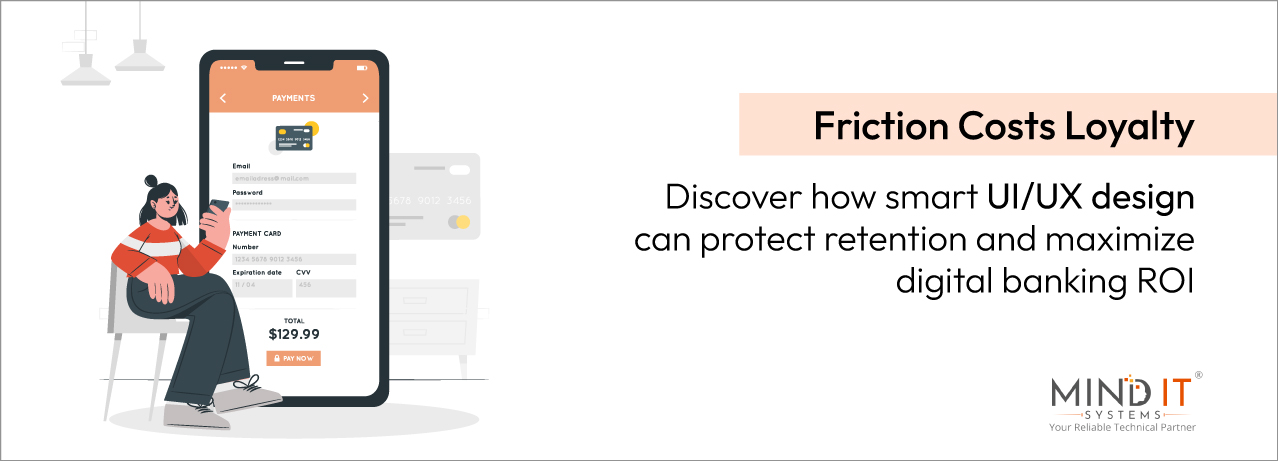
From Friction to Flow: Data-driven UI/UX for Reducing Customer Churn in Banking Apps
I nearly hurled my phone across the room last week. Not kidding. I just wanted to see how much I’d spent on my groceries last month. I launched my banking app—the one with the big, reputable bank I’ve been with for more than a decade—and entered a special hell. Five taps, three other loading spinners, a nonsensical chart that meant nothing, and then – nothing. I gave up. I, the person who exists and survives user experience for a living, was beaten by a simple task.
If I’m frustrated to this level, what are your customers experiencing?
Let’s just be real with each other for a second. Your banking app, the one you’ve most likely spent millions developing, is most probably a leaky bucket. It’s losing you customers silently, not because your fees are too steep or your loan interest isn’t competitive, but because it’s just so annoying to navigate. Each frustrating menu, each interminable loading screen, each moment when the user says, “Ugh, I’ll do it later,” is an escaping drop of water. And that bucket is draining faster than you realize. The typical bank is losing almost 18% of its customers to churn [1]. That’s nearly one in five. It’s an appalling figure that should be keeping you awake at night.
But look at the digital-only banks, the “neobanks.” Their churn rate? Barely more than 10% [1]. What’s their magic trick? Not some newfangled financial product. It’s a single-minded, relentless, data-driven obsession with making their apps not just functional, but fun.
The Silent Killer: Death by a Thousand Taps
Big banks had a captive customer base for the longest time. Changing banks was a hassle, so we all just tolerated clumsy apps and subpar digital banking. That time has passed. The dam has burst. Customers have an idea now of what a good app is like—they use them every day to order food, plan travel, and listen to music. And they’re beginning to wonder why their banking app is like something from 2010.
When customers depart, it’s not necessarily about the benjamins. Of course, excessive fees are the leading driver (43%), but close on its heels are bad customer service (39%) and—this is the one you should highlight in red—limited digital capabilities (32%) [1]. One-third of your exit customers are leaving because your digital front door isn’t working. They’re not demanding the universe; they’re demanding a working tool, a respectful tool that honors their time. When it doesn’t show up, they leave.
Let’s Discuss Money: The Ridiculous ROI of a Great Experience
I can already imagine the blowback from the accounting department. “We can’t really afford a dramatic UX overhaul at the moment.” My answer never wavers: you can’t afford not to. This isn’t a cost; it’s an investment with a return that’s almost laughably high. Forrester Research put a number on it that I’ve used to win over countless skeptical executives: for every $1 you invest in UX, you get $100 back [2]. A 9,900% ROI. It sounds made up, but it’s real.
How does that actually play out? It’s not just fuzzy “customer delight.” It’s cold, hard cash.
| Business Result | The Cost of Doing Nothing | The Return on Intelligent UX |
|---|---|---|
| Customer Retention | Losing 1 out of every 5 customers. | Reduce churn by as much as 18% using predictive analytics [1]. |
| Acquisition | Poor app store ratings actively deter new customers. | Double mobile-driven sales and new customer acquisitions [3]. |
| Efficiency | Your call center is overwhelmed with users who can’t navigate the app. | Fix 80% of typical issues automatically in the app [3]. |
| Engagement | Your app is a ghost town. | Increase 51% more customer interactions and 26% engagement [1, 3]. |
I watched this happen to a mid-tier bank a few years ago. Their app was a disaster. It was a patchwork of legacy systems that had been cobbled together over the years, and it was obvious. We didn’t put a veneer of new paint on it. We went all-out data geeks. We utilized heatmaps to observe where individuals were rage-tapping out of frustration. We just observed actual customers sitting down and attempted to do things. We A/B tested just about everything, from the color of a button to the text on a menu.
The outcome was breathtaking. In six months, calls to their support center related to apps decreased by a fifth. The time it took for people to perform a simple transfer was halved. And their app store rating improved from an embarrassing 2.5 stars to a solid 4.5. That’s not a vanity metric. That’s your new, free marketing department.
How to Stop Guessing and Start Knowing
So, how do you do it? You quit speculating about what your customers want and begin to listen to what their actions say. The data is a story. You just need to know how to read it.
McKinsey has a super jazzy framework for this, but I like to reduce it to four common-sense concepts:
- Make it Dead Simple. This is non-negotiable. Your app has to be as easy to use as a light switch. If someone has to stop and think, you’ve failed. This means being ruthless about cutting out unnecessary steps and clutter.
- Make it About Me. My app needs to be like a personal banker in my pocket. Use the information you have to provide me with smart insights. Show me where my money goes. Nudge me when I’m going to overspend. Customers who receive this type of tailored support are 7 times more likely to remain [1].
- Predict What I Need. This is the future. With new AI, you can predict what a shopper is about to do next with eerie accuracy—about 90%, as some research has found [3]. Picture an app that knows I’m most likely attempting to complain about a charge and is willing to assist ahead of time before I need to find the appropriate menu. That’s the future.
- Don’t Hit a Dead End. For the occasional time when the app can’t fix the issue, don’t just leave the customer in a generic support pool. Be smart. If they’re viewing mortgage rates, route them to a loan officer. If they’re experiencing a transaction problem, provide a live chat with a fraud expert.
This isn’t hypothetical. Take Emirates NBD for example. They went all in on a digital transformation with their ENBD X app. The outcome? A 65% increase in profits [4]. They didn’t do it by mistake. They did it by making user experience a core business strategy.
Your First Move
If any of this feels familiar—if you’ve ever been frustrated by your own company’s app—then it’s time for a change. And it starts with a simple question to your team: “Show me the data.”
Where are people getting stuck? What’s the one task that generates the most support calls? What’s the feature that everyone says they want but no one actually uses?
The solutions are right there, in your analytics, in your support logs, in your app store reviews. That information is a roadmap. It will tell you exactly where the friction is. And once you know, you can begin turning that friction into flow.
Your customers speak to you every single day through their swipes and their taps. The only question is whether you’re prepared to listen. And you can always get in touch with Mind IT®, I work there as UI/UX expert.
References
1. CoinLaw. (2025). Banking Customer Retention Statistics 2025. https://coinlaw.io/banking-customer-retention-statistics/
2. Forrester Research. (2023). The ROI Of UX. https://www.forrester.com
3. McKinsey & Company. (2025). Building a world-class mobile-banking app. https://www.mckinsey.com/industries/financial-services/our-insights/banking-matters/building-a-world-class-mobile-banking-app
4. UXDA. (2024). Emirates NBD Case Study: Strategic UX Drives Ecosystem ROI. https://theuxda.com/blog/emirates-nbd-case-study-driving-roi-with-strategic-ux-in-middle-east-banking
Share this post
About the Author

Ekalavya Singhania
Design Lead
Ekalavya Singhania is a Product & UX Designer, who is passionate about understanding people’s behavior and needs to craft exceptional experiences for them.

